Corporações // Apresentação sumária dos CBs (enfoque no período)
• BVL Bombeiros Voluntários de Lisboa
• BVA Bombeiros Voluntários da Ajuda
• BVL Bombeiros Voluntários Lisbonenses
• BVCO Bombeiros Voluntários de Campo de Ourique
• BVCM Bombeiros Voluntários da Cruz de Malta
• BVBO Bombeiros Voluntários do Beato e Olivais (designação desde 2010: Bombeiros Voluntários do Beato)
• BVCR Bombeiros Voluntários de Cabo Ruivo
Para leitura dos dados disponíveis relativamente a cada viatura: pousar o ponteiro do rato sobre o tipo de informação desejada,
nas tabelas respectivas
For watching the available data, with regard for a particular apparatus: pause the mouse pointer on the category sought,
in the table concerned
BVCM - Bombeiros Voluntários da Cruz de Malta
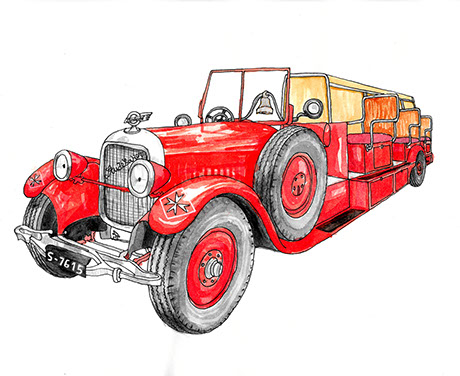
F01a
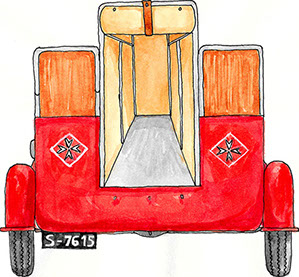
F01b
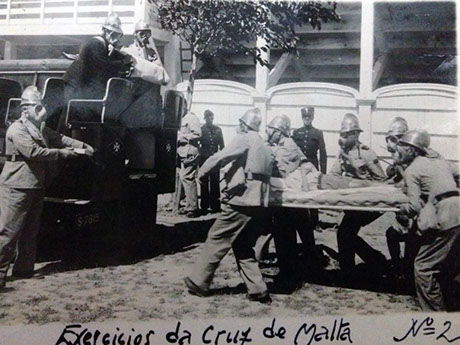
F01c
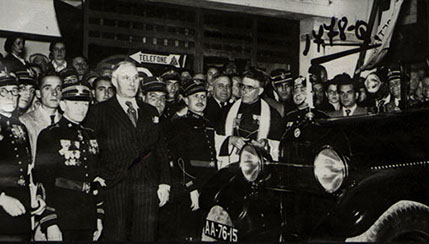
PS-AM
1925
1936/1942
S-7615 / AA-76-15
Studebaker
F01a,b© Hugo Lami;
F01c ©AHBVCM;
F01d ©AF Torre do Tombo
Tipologia // Typology
Ano R // Year R
Ano(s) S // Year(s) S
Matr. // Reg.
Marca_Modelo // Brand_Model
Factos // Facts
©
F01a/F01b: Interpretação criativa de um Studebaker comercial de 1925, convertido em Pronto-Socorro (assim então designado) sob projecto dos BVCM e inaugurado em 1936, a partir de uma viatura privada de transportes públicos oriunda da vila da Lourinhã. Esta viatura de socorro, de características únicas no panorama nacional, combina as valências de transporte de pessoal e de ambulância rudimentar para um doente ou sinistrado. Numa 1ª fase, entre 1936 e 1942, permitia o transporte simultâneo de : 1 motorista + 7 outros bombeiros/socorristas (dos quais 6 em cadeiras individuais laterais sobre caixa traseira aberta). Dispunha de uma célula sanitária improvisada no eixo centrar da caixa aberta traseira, entre a base da plataforma traseira e o topo da viatura. Aparentemente seria usada uma cobertura de lona como invólucro da célula (concepção porventura inspirada nas antigas macas rodadas de tracção manual, das quais os BVCM possuíam pelo menos uma…). De acordo com a imprensa da época os encargos com esta aquisição e transformação (cerca de 4 000 Escudos) foram suportados pela então Delegação da Cruz de Malta em Porto Amélia (Moçambique), cujo Comandante do CB local teria alegadamente exercido também e interinamente iguais funções em Lisboa. Desta originalíssima viatura não existem imagens integrais (apenas vistas parciais muito incompletas) aqui constando pois uma interpretação artística do carroçamento de 1936, incluindo detalhe relativo ao acesso traseiro à célula sanitária improvisada.
F01c: Esta imagem de Julho de 1940 documenta o papel da viatura (na sua versão com “caixa traseira aberta; entre 1936 e 1942) num exercício de evacuação de sinistrados em contexto de guerra química. Tal simulacro, repetido por várias vezes em Portugal nos anos 1940-1942, reflectia a preocupação das Autoridades perante uma ameaça típica do apogeu da II Guerra Mundial: o bombardeamento aéreo das áreas urbanas com engenhos libertadores de gases tóxicos; como se pode ver os socorristas usam máscaras de filtro, a par dos tradicionais capacetes de latão embora nenhuns outros meios de protecção individual.
F01d: A viatura seria novamente transformada em 1942, mediante o fecho de parte da secção traseira para nela conter todo o equipamento respeitante ao hospital de campanha móvel então operado pelos BVCM; nesta fase a secção frontal transportava: 2 + 3 bombeiros/socorristas, em 2 bancos transversais (desconhecendo-se porém se em caixa aberta ou fechada). Esta imagem respeita à inauguração da nova versão, à porta do quartel à data. Desconhece-se a data do abate ao serviço activo bem como o posterior destino da viatura.
F01a/F01b: Creative interpretation of a 1925 Studebaker light duty truck, converted into a first-aid responder (Pronto-Socorro, as then named) under design of the Cruz de Malta FD. Originally the truck was a privately operated public transportation unit, at the village of Lourinhã. This apparatus, of a unique profile within the framework of Portuguese FDs, combined the roles of both a personnel carrier and a single patient ambulance. During the first period of operation by the Cruz de Malta VFD (1936-1942) the rig could simultaneously carry: 1 driver + 7 other FFs/Rescuers (of which 6 seating in individual chairs along both sides of the open rear body). It also carried an in-built makeshift sanitary cell, centrally located on the rear open platform, from ground to top. Apparently a canvas cover was used to provide shelter to the cell (this concept was probably inspired in the design of the old hand-drawn wheeled stretchers, one of which at least was held by the Cruz de Malta VFD…). According to the media of that time the costs for the purchase and conversion of the rig (about 4000 PT Escudos) were born by the Cruz de Malta Delegation
At Porto Amélia (Mozambique), which local Fire Chief would also have been the acting Fire Chief for Lisbon’s Cruz de Malta VFD. There are no full pictures of this very peculiar apparatus (only partial ones, of a poor quality are available); therefore what is delivered in here is an artistic interpretation of what could have been the 1936 bodywork, including a view for the rear access to the rudimentary sanitary cell.
F01c: This picture elucidates the role of this apparatus (the “open box version” of it; between 1936-1942), at one simulation exercise in July 1940 involving the evacuation of casualties, in a context of chemical warfare. This type of operations, which was performed a number of times in Portugal in the years 1940-1942, reflected the concern at that time by the Authorities about a typical threat during the more critical times of WWII: planes bombing urban areas with toxic gases devices. As it can be seen the rescuers wear plain filter masks, along with the traditional Portuguese brass helmets, while no other means of individual protection are used.
F01d: The apparatus was transformed again in 1942, by means of enclosing the full rear section, so that it could house under cover the full gear pertaining to the mobile field hospital which was then operated by the Cruz de Malta VFD. In this new version the front section would carry 2 + 3 FFs/Rescuers, seating in two transversal seats (not clear if, whether or not, the personnel would ride in a fully enclosed. This picture illustrates the inauguration ceremony (in front of the then Fire-house). The date of the end of the rig’s operational activity is not known, neither its future ownership or operation could be traced.
F01d
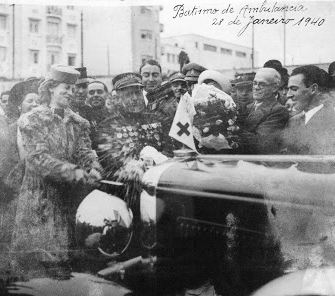
F02
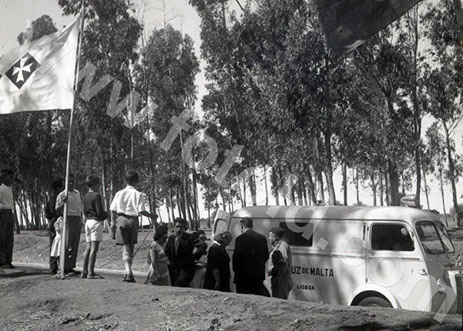
Hospital de campanha (vista parcial)
-
-
-
-
Auto-Maca sem referências exactas disponíveis, excepto ter sido inaugurada em 1940 pela filha do então Presidente da CM de Lisboa. Possível adaptação de um veículo ligeiro já usado, será esta viatura, muito provavelmente, a que figura em F22, imediatamente à esquerda da tenda do hospital e campanha.
Ambulance, with no objective data available, depicted here at the inauguration act presided by the daughter of the then Lisbon’s Mayor. This vehicle is probably a 2nd hand transformation of a family car; it is likely to be the rig appearing first at the left hand side of the field hospital’s tent in F22.
©AHBVCM
Tipologia // Typology
Ano R // Year R
Ano(s) S // Year(s) S
Matr. // Reg.
Marca_Modelo // Brand_Model
Factos // Facts
©
AM
-
1954 (inauguração)
1954 (inauguration)
EA-15-04
Peugeot D3
Não disponível
Not available
©fotold.com
Tipologia // Typology
Ano R // Year R
Ano(s) S // Year(s) S
Matr. // Reg.
Marca_Modelo // Brand_Model
Factos // Facts
©
F16
F16
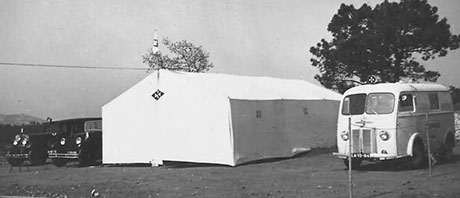
F22
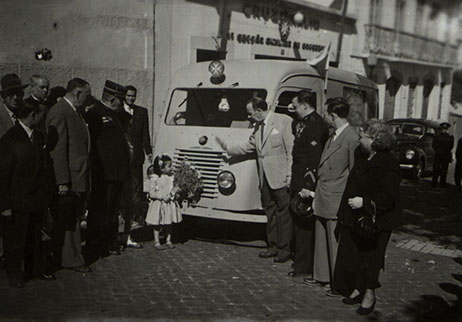
F15
Hospital de campanha (vista parcial)
-
-
-
-
F22: Hospital de campanha montado no âmbito de um exercício, em data não determinada (possívelmente entre 1951-1954) : tenda-abrigo + 3 viaturas de apoio; 1 AM Peugeot de 1951 e (parcialmente visíveis): 2 outras viaturas, mais antigas, não imediatamente referenciáveis (podendo uma ser a representada em F01d e outra a constante de F02)
F22: Field hospital with 3 support apparatus featured: 1 Peugeot ambulance, dated 1951 (partially visible only): two not immediately identifiable older ones ( one of the latter may be is the vehicle also showing in F01d and the other the one showing in F02). The picture was taken during an excercice probably dated between 1951 and 1954
©AHBVCM
Tipologia // Typology
Ano R // Year R
Ano(s) S // Year(s) S
Matr. // Reg.
Marca_Modelo // Brand_Model
Factos // Facts
©
AM
-
1951 (inauguração)
1951 (inauguration)
CL-13-17
Renault (1000 Kg)
Não disponível
Not available
©AF Torre do Tombo
Tipologia // Typology
Ano R // Year R
Ano(s) S // Year(s) S
Matr. // Reg.
Marca_Modelo // Brand_Model
Factos // Facts
©
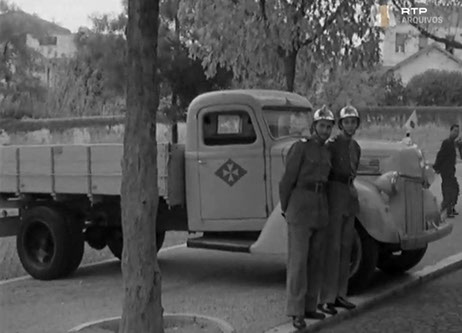
F17
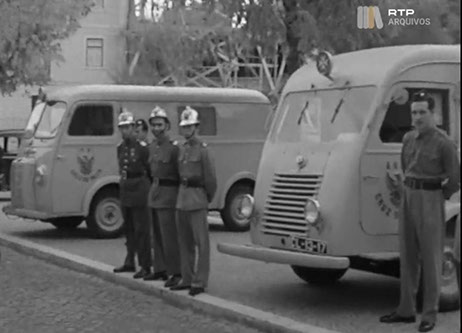
F20
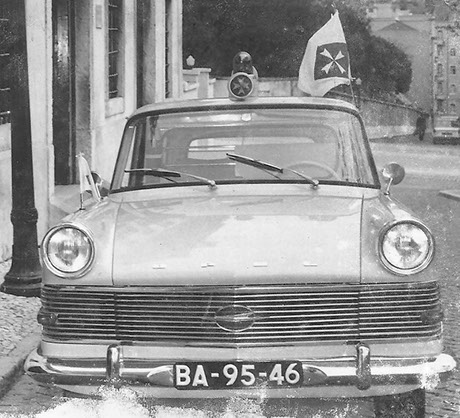
AA
-
antes / before 1957
CL-13-17
-
AA- Camioneta de transporte geral (caixa aberta), sem dados disponíveis (nem equipamento visível), excepto que surge em registo TV de cerimónia de inauguração datada de Setembro de 1957. Presume-se que a utilidade imediata desta viatura (que figura sem luzes avisadoras de marcha urgente, embora com o símbulo e flâmula da Cruz de Malta) fosse o transporte dos meios respeitantes ao hospital de campanha, após o abate ao efectivo da viatura figurada em F01 (que terá ocorrido após a data do simulacro figuardo em F22).
Utility-General purpose flat bed/open rear box truck, of which there is no data available (no equipment is visible also), except that it was captured on a TV record of an inauguration ceremony held in September 1957. It is assumed that this apparatus (not fitted with warning lights also sporting the Malterser crest and banner) was used to carry the field-hospital equipment/gear, following the disposal of the rig depicted under F01 (some time after the simulation exercise displayed in F22).
©Arquivos da RTP
Tipologia // Typology
Ano R // Year R
Ano(s) S // Year(s) S
Matr. // Reg.
Marca_Modelo // Brand_Model
Factos // Facts
©
AM
1951 e/and 1954
antes / before 1957
CL-13-17 e/and EA-15-04
-
Conjunto (AM)- Duas ambulâcias francesas dos primórdios das células sanitárias em “caixa alta”, ambas da década de 50 Peugeot modelo D3 (1954?; vide também F22) e Renault “1000 Kg”. Ambas visíveis em cerimónia inauguratória em 1957.
Group (AM)-Two French-made ambulances of the early times of the “high gauge” sanitary cell design, dating from the early 50s: Peugeot D3 model (see also F22) and Renault “1 Ton”. Both vehicles are visible in one inauguration act held in 1957
©Arquivos da RTP
Tipologia // Typology
Ano R // Year R
Ano(s) S // Year(s) S
Matr. // Reg.
Marca_Modelo // Brand_Model
Factos // Facts
©
AM
Auto Maca
1961?
-
BA-95-46
Opel
De notar as flâmulas bem como o símbolo de Malta na luz de aviso (único CB em Lisboa que o utilizou)
To be noted the pennants and the warning light displaying the Malteser symbol (sole FD in Lisbon to sport it)
©AHBVCM
Tipologia // Typology
Ano R // Year R
Ano(s) S // Year(s) S
Matr. // Reg.
Marca_Modelo // Brand_Model
Factos // Facts
©
F03
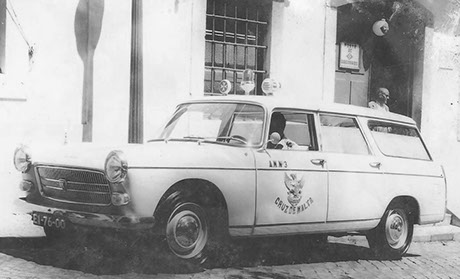
AM
Auto Maca e pessoal
-
1962?
EI-76-00
Peugeot 204
AM3; Notar o símbolo iluminado da Cruz de Malta pendente sobre a porta de entrada (também visível em F05 e F06)
AM#3; Note the Malteser illuminated symbol hanging above the entrance door (also visible in F05 and F06)
©AHBVCM
Tipologia // Typology
Ano R // Year R
Ano(s) S // Year(s) S
Matr. // Reg.
Marca_Modelo // Brand_Model
Factos // Facts
©
F04
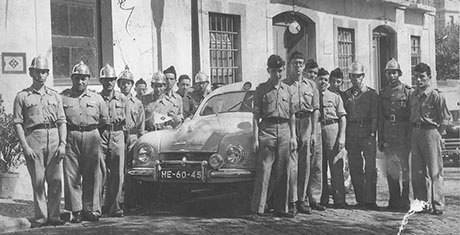
F05
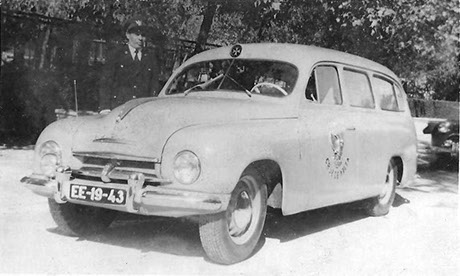
F07
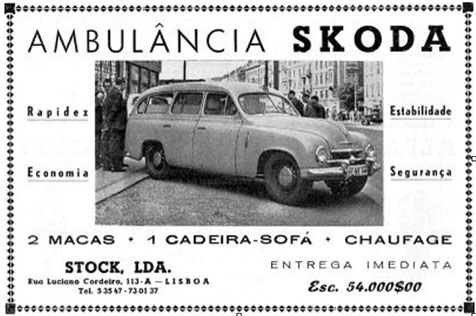
F08
AM
Auto Maca e pessoal
1960 ?
1959 ou/or 1960
HE-60-45
Skoda
Esta ambulância, parqueada junto ao quartel (de reduzidas dimensões), é uma das AM Skoda operadas por este CB nos anos 50-70 (vide outro veículo em F07). De notar o símbolo de Malta na luz de aviso da viatura (único CB em Lisboa que o utilizou). De notar ainda quer os capacetes de latão então em uso quer o botão de chamada (para “alarme de porta”) encastrado na parede e iluminado no período nocturno.
This ambulance, parked by the minimal Fire Station, is one of the Skoda units operated in the 1950’s-1970s period (see another one in F07). Note the vehicle’s warning light displaying the Malteser symbol (sole FD in Lisbon to use it). To be also noted the brass helmets sported by the volunteers as well as the illuminated public alarm-call button in the wall of the Fire-House
©AHBVCM
Tipologia // Typology
Ano R // Year R
Ano(s) S // Year(s) S
Matr. // Reg.
Marca_Modelo // Brand_Model
Factos // Facts
©
AM
Auto Maca
1972?
1972?
EE-19-43
Skoda
Esta ambulância é uma das AM Skoda operadas nas décadas de 50 a 70 (vide outro veículo da mesma marca em F05). De notar o símbolo de Malta na luz de aviso da viatura (único CB em Lisboa que o utilizou). De notar também que, apesar das reduzidas dimensões das AM SKODA, cada uma destas podia transportar, simultaneamente, 2 doentes ou sinistrados…
This is the one of the SKODA ambulances operated by this FD in the decades 1950-1970 (see another one in F05); to be noted the warning light displaying the Malteser symbol (sole FD in Lisbon to sport it). To be also noted that, despite the small size of the Skoda Ambulances, those could accommodate 2 stretcher-case casualties simultaneously…
©AHBVCM
Tipologia // Typology
Ano R // Year R
Ano(s) S // Year(s) S
Matr. // Reg.
Marca_Modelo // Brand_Model
Factos // Facts
©
AM
Auto Maca
-
-
-
Skoda
Anúncio do representante da marca Skoda em Portugal, propondo a versão-base para AM; este CB adquiriu e operou pelo menos, 5 destas viaturas, no período nas déadas de 50 a 70 (duas reprsentadas nas fotos F05 e F07); as seguintes matrículas foram referenciadas: DC-20-37, EE-10-43, FE-20-32, HE-60-43 e GD-55-73
Press ad of the commercial representative for the SKODA brand in Portugal, offering the basic ambulance version of their vans. This FD has operated at least 5 very similar Skoda ambulances, in the period 1950’s-1970’s (two are depicted here under F05 and F07); the following plate numbers were identified: DC-20-37, EE-10-43, FE-20-32, HE-60-43 e GD-55-73
-
Tipologia // Typology
Ano R // Year R
Ano(s) S // Year(s) S
Matr. // Reg.
Marca_Modelo // Brand_Model
Factos // Facts
©
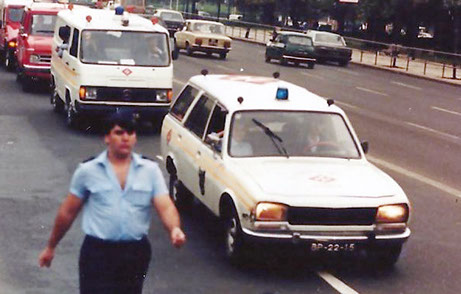
Desfile em 1982 com 2AM: Mercedes Benz (matr. NB-35-35) e Peugeot (matr. BP-22-15)
-
-
-
-
Desfile conjunto de diversos CBs com 2AM dos BVCM: Mercedes Benz e Peugeot (matr. BP-22-15)
A multi-FD parade with two FD Cruz de Malta ambulances: one Mercedes Benz and one Peugeot (BP-22-15)
©AHBVCM
Tipologia // Typology
Ano R // Year R
Ano(s) S // Year(s) S
Matr. // Reg.
Marca_Modelo // Brand_Model
Factos // Facts
©
F09
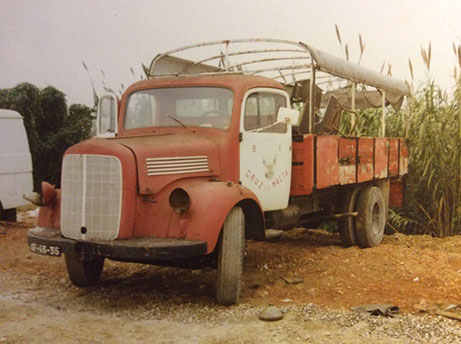
TPP
-
Final dos anos 70
Dated end of 70’s
IF-45-35
Mercedes
Viatura pesada de transporte de pessoal e material, cobertura integral de lona. Mercedes Benz. Final dos anos 70. Operada anteriormente pela GNR
Heavy personnel and equipment carrier/Heavy duty utility. Mercedes-Benz, rear section fully covered with canvas. Dated end of 70’s. Formerly operated by GNR (National Guard)
© VABP
Tipologia // Typology
Ano R // Year R
Ano(s) S // Year(s) S
Matr. // Reg.
Marca_Modelo // Brand_Model
Factos // Facts
©
F23
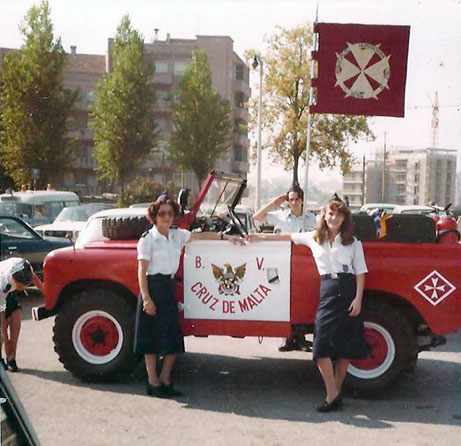
AA
Auto Auxiliar
1971 (?)
-
-
-
Jeep Land Rover (transporte de pessoal e apoio geral) com equipa feminina em destaque (provavelmente socorristas certificadas), pronto para desfile. De notar o estandarte de honra arvorado
The utility Land Rover jeep (ready for parade duty). Note the 3 female crew (certified EMS staff most likely). Note also the honour flag hoisted
©AHBVCM
Tipologia // Typology
Ano R // Year R
Ano(s) S // Year(s) S
Matr. // Reg.
Marca_Modelo // Brand_Model
Factos // Facts
©
F10
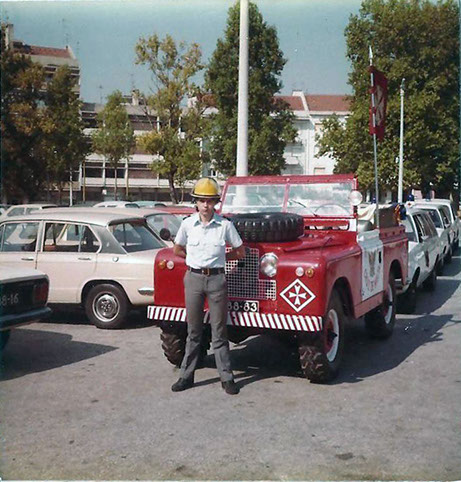
Foto de Conjunto
Group picture
-
-
-
Citroën H
Jeep Land Rover (transporte de pessoal e apoio geral) com diversas AM visíveis em 2º plano, em prontidão para serviço de parada. Notar o estandarte de honra arvorado. Notar ainda que a cor vermelha da viatura, a par do Bombeiro usar um capacete de combate de estilo moderno, indiciam o início(?) da valência Serviço de Incêndios neste CB
The utility jeep with three AMs visible behind it (ready for parade duty; note the honour flag hoisted). The red color all-over along with the Firefighter sporting a modern style helmet illustrates the trend (?) towards this FD also engaging in fire-fighting response duties.
©JMT
Tipologia // Typology
Ano R // Year R
Ano(s) S // Year(s) S
Matr. // Reg.
Marca_Modelo // Brand_Model
Factos // Facts
©
F11
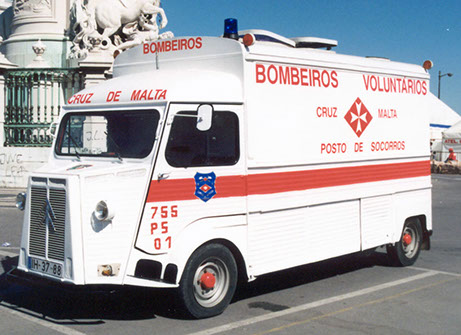
F12a
PS
Posto de Socorros
-
-
IH-37-88
Citroën H
Unidade móvel de 1ºs socorros similar aos que outros 4 CB da cidade de Lisboa operaram na mesma época ou anteriormente (BV de Lisboa-a confirmar, BV da Ajuda-sem imagem, BV Lisbonenses-D17 e BV de Campo de Ourique-E07); este CB utilizou, sucessivamente, duas viaturas distintas com esta tipologia (F12 representa a mais recente), desconhecendo-se porém mais detalhes
The mobile first-aid station (the 2nd and more modern of two operated) is similar to the same type of vehicle operated, around the same period, by 4 other Lisbon FDs: Lisboa-yet to be confirmed, Ajuda-no image available, Lisbonenses-D17 and Campo de Ourique-E07. No additional information is available
©JMT
Tipologia // Typology
Ano R // Year R
Ano(s) S // Year(s) S
Matr. // Reg.
Marca_Modelo // Brand_Model
Factos // Facts
©
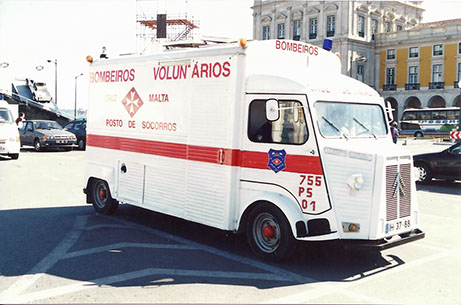
F12b

F13
Foto de Conjunto: pessoal e 2 viaturas
-
-
-
-
Pessoal e 2 viaturas à porta do quartel: AT Bedford, com AC/AA jeep Portaro de 1978 parcialmente visível (datas e matrículas desconhecidas para ambos); estas unidades constituiriam à data, provavelmente, a totalidade dos meios-auto afectos à valência Serviço de Incêndios deste CB.
Parked by the Fire Station doorway: one Bedford AT and one 1978 Portaro jeep AA/AC are visible behind the line of volunteer personnel, on what looks to be a festive event (details unknown for both rigs); that was probably the full fire-fighting sub-fleet at the time).
©AHBVCM
Tipologia // Typology
Ano R // Year R
Ano(s) S // Year(s) S
Matr. // Reg.
Marca_Modelo // Brand_Model
Factos // Facts
©
AT
-
-
LB-97-59
Bedford
AT-Esta viatura é uma das 4 idênticas operadas pelo BSB (lote em serviço desde 1968) as quais, após abate ao efectivo naquele CB foram doadas a 4 CBVs da cidade: (BV Lisboa, BV Ajuda, BV Cruz de Malta e BV Cabo Ruivo; vide B17, C11 e H05). Dispunha de bomba e de meios básicos de combate autónomo e necessário; a imagem F18 respeita a um período transitório em que a viatura aguardou acabamentos (e entrada ao serviço activo, que se estima haja sido em Janeiro de 1975), no espaço amplo do quartel dos BV de Campo de Ourique.
AT: this tanker/water carrier is one of a lot of 4 identical apparatus operated by the BSB as from 1968, which were donated (after discharge from active duty) to 4 of Lisbon’s Volunteer FDs (de Lisboa, da Ajuda, Cruz de Malta and de Cabo Ruivo; vide B17, C11 and H05); the F18 image is from a transient period were the rig was parked in the BV de Campo de Ourique wide Fie House facilities, while awaiting for new owner’s fitting and re-start of active duty (estimated to have taken place on January 1975).
©Frank Sidney
Tipologia // Typology
Ano R // Year R
Ano(s) S // Year(s) S
Matr. // Reg.
Marca_Modelo // Brand_Model
Factos // Facts
©
APS
-
-
FF-87-84
Chervolet
APS-Esta viatura Chevrolet é uma de 10 unidades a serviço do BSB desde 1972 (não figurados neste site), que vieram susbstuituir os lotes Ford de 1956 (APS; A35) e de 1961 (PSTT; A39). Após abate ao serviço activo foi inicialmente atribuída aos BV da Ajuda (vide C13), tendo depois transitado para os BV da Cruz de Malta antes de abate final em data desconhecida.
APS-This engine/pumper is one of 10 purchased by the BSB in 1972 with the purpose of replacing the former Ford units (1956 APS; A35) and 1961 PSTT; A39). After discharge from active duty this unit (no picture in tis web-site) was donated to the VFD da Ajuda (see C13), which in turn transferred it to the VFD Cruz de Malta where it was scrapped at an unknown date.
©Frank Sidney
Tipologia // Typology
Ano R // Year R
Ano(s) S // Year(s) S
Matr. // Reg.
Marca_Modelo // Brand_Model
Factos // Facts
©
F18
O futuro: algumas viaturas post 1979
The future: some post-1979 apparatus
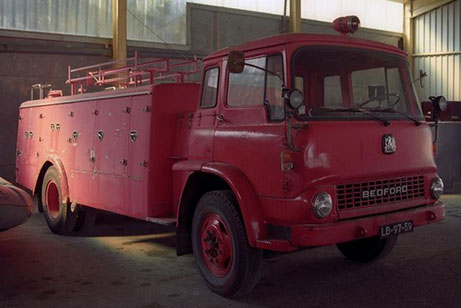
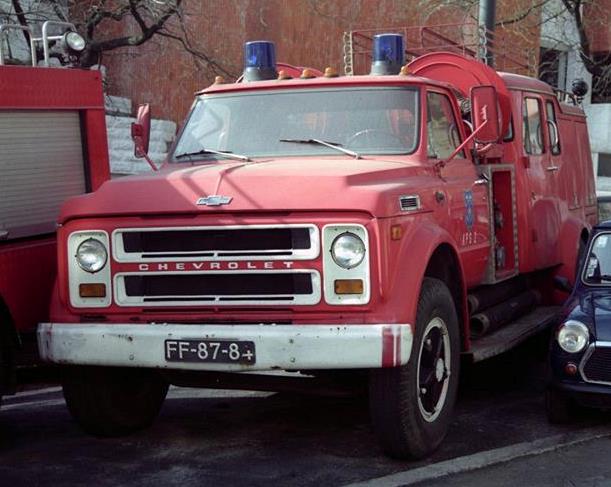
F94
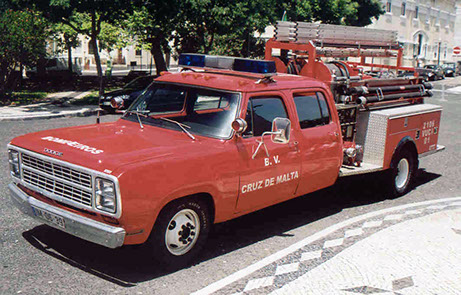
PSL
Pronto Socorro Ligeiro
1978 (?)
-
IM-06-39
Dodge/Pierce/Jacinto M.O.
APS urbano (da década de 70?) com corpos de escadas metálicas e barra de luzes moderna; viatura referenciada, também, nos BV da Ajuda (C91) e nos BV de Sacavém; desconhece-se qual o período exacto em que esta viatura esteve activa nos BVCM
Urban APS (dating from the 70‟s?), that was once owned by the Ajuda FD (see C91) and also by the Sacavém FD (near Lisbon); no precise dates known for active duty in the Cruz de Malta FD. Note the metallic (not wooden anymore) set of ladders and also the modern style lights bar
©JMT
Tipologia // Typology
Ano R // Year R
Ano(s) S // Year(s) S
Matr. // Reg.
Marca_Modelo // Brand_Model
Factos // Facts
©
F91a
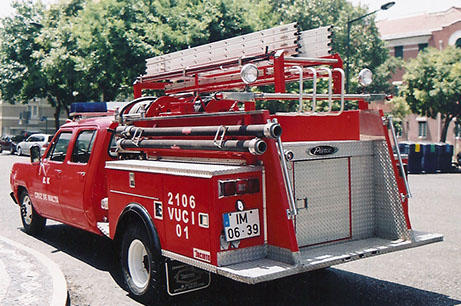
F91b
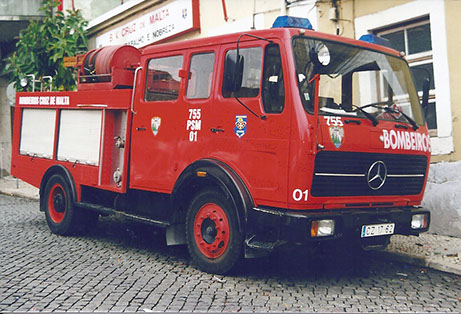
F92a
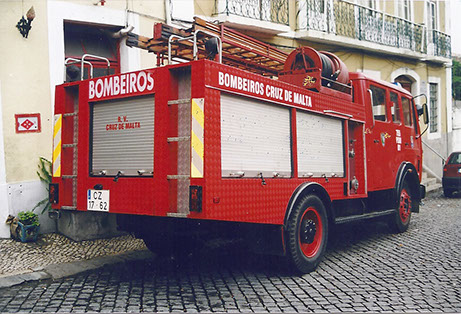
PSM
Pronto Socorro Médio
1975
-
CZ-17-62
Mercedes Benz 1017
Viatura cedida (provavelmente na década de 80), após abate ao serviço activo no BSB, com início em 1977. Observada ainda no combate a um incêndio urbano, no início da década de 2000, apoiando a intervenção dos BVCM na sua então área primária de intervenção. De notar o uso, ainda, de escadas em madeira. Esta viatura seria a última de Serviço de Incêndios operada por este CB, o qual foi dissolvido em 2015
This apparatus (new in 1979) was donated by the ex-BSB, after retirement from active duty, likely in the 80‟s; still equipped with the old style wooden ground ladders. It was seen in active duty when responding to an urban fire in the primary FD intervention area, in the middle of the 2000 decade. It was the last fire service rig operated for this FD, which was disbanded in 2015
©JMT
Tipologia // Typology
Ano R // Year R
Ano(s) S // Year(s) S
Matr. // Reg.
Marca_Modelo // Brand_Model
Factos // Facts
©
F92b
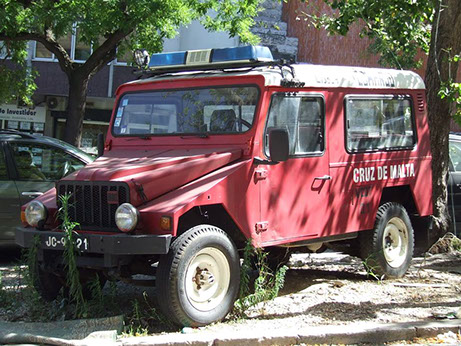
AC/AA/TPL
Auto-comando ou Auto-Apoio ou Transporte de Pessoal Ligeiro
Chief’s car/Light personnel carrier/Light utility
-
1985 (?)
JC -9X-21
UMM
Não disponível
Not available
© VABP by F.Domingos
Tipologia // Typology
Ano R // Year R
Ano(s) S // Year(s) S
Matr. // Reg.
Marca_Modelo // Brand_Model
Factos // Facts
©
F93
© LIS50 | 2016 50 anos de veículos automóveis dos Bombeiros de Lisboa-de 1930 a 1979 // (iniciativa privada, de âmbito histórico, sem fins lucrativos)Por razões de rigor histórico aceitam-se e agradecem-se todos os contributos válidos, institucionais ou individuais, tendentes a complementar ou a aperfeiçoar os elementos factuais e as imagens aqui constantes - lis50.info@gmail.com


